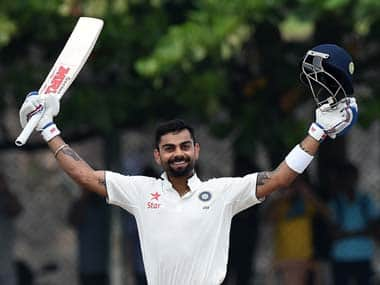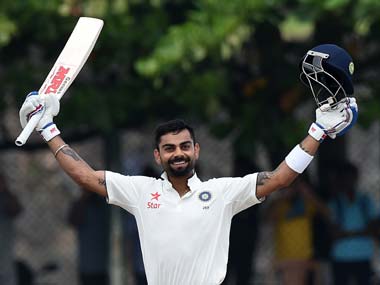Depending on how you look at it, Virat Kohli either picked up where he left off after India’s Test series against Australia or he rediscovered his form after a lean trot that began at the World Cup and continued through the Bangladesh series. When Kohli walked out to bat yesterday, a colleague of mine said Kohli was out of form and India needed him to make runs again. Yet Kohli’s Test average over the last 12 months (excluding this game) was 66.54. That does not indicate a man out of form, quite the opposite in fact. [caption id=“attachment_2391700” align=“alignleft” width=“380”]
 Virat Kohli celebrates his fourth hundred as captain. AFP[/caption] However, Kohli’s average in ODIs in 2015 is 31.50. Given that he averaged 55.20 from 2013 to 2015, his form appeared to have dropped off considerably. And since his last Test prior to the one-off match against Bangladesh in June was in January, his one-day form would seem to be more relevant by virtue of being more recent. But that assumes a batsman’s form in one format reflects his form in another and that’s far from certain. The ability to make 40 from 22 balls in a T20 game is very different from the ability to grind out a century over the course of a full day. The very best players can often do both, but they still require different skills and different mental approaches. And on a more meta level, there’s the question of what it means for a batsman to be in or out of form. In an interview with the Indian Express in September of last year, Cheteshwar Pujara had
this to say
about his form after India’s tour of England, where he failed to get to 25 in his last six innings. “I never really felt I was batting badly or the bowlers were troubling me very much, to be honest. Let me explain. I scored two fifties in the practice games and then again got to fifty in the first Test at Trent Bridge. Now that is universally considered as being in form. But what I am trying to say is that even in Lord’s, or Southampton and Manchester for that matter, when the runs didn’t reflect my form, I felt very much in it.” If Pujara is right, then there isn’t a correlation between form and runs and form is more of a state of mind and body that doesn’t always translate into runs. This appears counter-intuitive but has a certain logic to it. A good ball doesn’t care if a batsman is in or out of form. In fact, if a batsman is in good form, he could well nick a ball he might have missed had he been out of form. Likewise, a batsman can scratch around at the crease, look uncomfortable and yet find himself making runs even though he feels his feet are not moving and his head isn’t close enough to the ball. Luck – or the law of averages – plays its part too. Kohli didn’t dominate against Sri Lanka like he did against Australia but he always appeared to be in control. Once he went past fifty, his century, his fourth as captain in four Tests, felt inevitable. He was solid and watchful in defence, and his most pleasing stroke, the cover drive where he uses his bottom-hand for power and placement, looked to be in fine working order. Appropriately, it was the shot he played to get to three figures. Together with Shikhar Dhawan, Kohli added 227 to put India in a commanding position before the last eight wickets fell for 120 runs. So, a return to form or a continuation? Neither seems to be the prudent answer. The rhythms of Test cricket are mystical and unclear, even to the players. Kohli is currently one of the Test cricket’s best batsmen and he is determined to succeed as a Test captain. The runs were always going to come at some point. That they did today has helped put India in prime position to win the first Test. And that should be good enough.
Virat Kohli celebrates his fourth hundred as captain. AFP[/caption] However, Kohli’s average in ODIs in 2015 is 31.50. Given that he averaged 55.20 from 2013 to 2015, his form appeared to have dropped off considerably. And since his last Test prior to the one-off match against Bangladesh in June was in January, his one-day form would seem to be more relevant by virtue of being more recent. But that assumes a batsman’s form in one format reflects his form in another and that’s far from certain. The ability to make 40 from 22 balls in a T20 game is very different from the ability to grind out a century over the course of a full day. The very best players can often do both, but they still require different skills and different mental approaches. And on a more meta level, there’s the question of what it means for a batsman to be in or out of form. In an interview with the Indian Express in September of last year, Cheteshwar Pujara had
this to say
about his form after India’s tour of England, where he failed to get to 25 in his last six innings. “I never really felt I was batting badly or the bowlers were troubling me very much, to be honest. Let me explain. I scored two fifties in the practice games and then again got to fifty in the first Test at Trent Bridge. Now that is universally considered as being in form. But what I am trying to say is that even in Lord’s, or Southampton and Manchester for that matter, when the runs didn’t reflect my form, I felt very much in it.” If Pujara is right, then there isn’t a correlation between form and runs and form is more of a state of mind and body that doesn’t always translate into runs. This appears counter-intuitive but has a certain logic to it. A good ball doesn’t care if a batsman is in or out of form. In fact, if a batsman is in good form, he could well nick a ball he might have missed had he been out of form. Likewise, a batsman can scratch around at the crease, look uncomfortable and yet find himself making runs even though he feels his feet are not moving and his head isn’t close enough to the ball. Luck – or the law of averages – plays its part too. Kohli didn’t dominate against Sri Lanka like he did against Australia but he always appeared to be in control. Once he went past fifty, his century, his fourth as captain in four Tests, felt inevitable. He was solid and watchful in defence, and his most pleasing stroke, the cover drive where he uses his bottom-hand for power and placement, looked to be in fine working order. Appropriately, it was the shot he played to get to three figures. Together with Shikhar Dhawan, Kohli added 227 to put India in a commanding position before the last eight wickets fell for 120 runs. So, a return to form or a continuation? Neither seems to be the prudent answer. The rhythms of Test cricket are mystical and unclear, even to the players. Kohli is currently one of the Test cricket’s best batsmen and he is determined to succeed as a Test captain. The runs were always going to come at some point. That they did today has helped put India in prime position to win the first Test. And that should be good enough.
Tariq Engineer is a sports tragic who willingly forgoes sleep for the pleasure of watching live events around the globe on television. His dream is to attend all four tennis Grand Slams and all four golf Grand Slams in the same year, though he is prepared to settle for Wimbledon and the Masters.
)